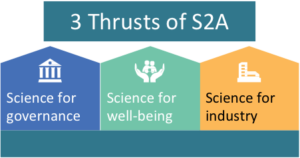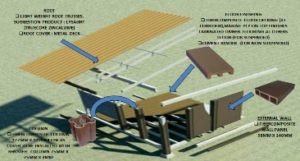About the case study:
The case study describes a unique method of developing an eco-transit home, by using local agriculture products. These transit homes can be made quickly by DIY (Do-It-Yourself) with minimum level of outside interventions, and can have good thermal comforts. The materials being light enough, can be transported easily to remote mountain areas. Through crowd sourcing and CSR (Corporate Social Responsibility) funding, this method can be promoted in different parts of the world.
Reference paper: Sivapalan Kathiravale (2016): Eco Transit Homes for Disaster Relief, in Shaw R., Izumi T., Shi P., Lu L., Yang S., Ye Q. (2016): Asia Science Technology Status for Disaster Risk Reduction, published by IRDR, Future Earth and ASTAAG, Beijing, China, 73-74.
Introduction
MIGHT which stands for Malaysian Industry-Government Group for High Technology is an independent, industry-driven, and non-profit organization that drives the advancement of high technology competency and capacity in Malaysia. It is a consensus-building platform based on a public-private partnership that develops strategies and pursues implementation through its numerous centers of excellence and partner organizations.
MIGHT was established on 22nd February 1993 and subsequently incorporated as a company limited by guarantee on 15th October 1994. It is placed in the Prime Minister’s Department to support the Science Advisor to the Prime Minister and leverage on the multi-disciplinary and inter-ministerial synergies from both the industry and Government. It is a membership organization that draws intellectual, financial and other resources support from selected Lead and ordinary members involved in the high technology development. The mission was: To serve the nation in advancing competency in high technology through partnership towards sustainable development .
The main function is to advice the Prime Minister on all matters relating to Science, Technology and Innovation (STI) by undertaking the following tasks, among others: 1) Prioritizing the role of STI for national development, 2) Strengthening the Investment for R&D, 3) Reinforcing the human capital for STI, 4) Encouraging STI based innovation in business, and 5) Promoting Science Diplomacy. Science to Action (S2A) is an existing initiative to ensure that Malaysia moves ahead as a developed country by 2020. The working framework is based on three thrusts, Science for Governance, Science for Well-Being and Science for Industry. Science for Governance is strategically centred on the intensification of Science, Technology and Innovation (STI) capacity of the nation and will take continued focus through the likes of Economic Transformation Program (ETP) and the Government Transformation Program (GTP). Under the thrust of Science for Governance, a policy review on the current level of R&D and innovation capabilities was undertaken by OECD as part of the S2A initiative. Through its wealth of information on a broad range of topics, OECD has helped governments foster economic growth and financial stability by analysing statistical, economic and social data. OECD has been continuously monitoring the S2A initiative, where recommendations for policy changes are made at the committee level and may subsequently evolve into discussions to implement the recommended steps for economic developments.
 Figure1. Thrust areas of S2A
Figure1. Thrust areas of S2AProblem
Terminologies such as “Transitional shelter”, “Progressive shelter” and “Core shelter” are often used for shelter after disasters and as a result of conflicts. Most terminologies relate to an approach rather than a phase of response, recognizing that post–disaster shelter is often built, upgraded and maintained by the affected populations themselves, and this self-management should be supported . A successful shelter needs a good balance of several points like time, cost, availability of materials, thermal comfort, people’s lifestyles etc.
Disaster victims are currently supplied with temporary tented shelter but in some cases victims may continue to live in these conditions for up to 6 months or even several years. Science and Technology is needed to find a solution that will provide improved living conditions with lasting structure that can be deployed easily and quick to be put up at an affordable price.
In most cases, especially in remote mountain areas, shelter construction becomes quite difficult, because of lack of available materials, difficulties in transport of materials, and its cost related issues.
Approach / Stakeholder participation
Eco Transit Homes are resilient and eco-friendly houses that can be built quickly by volunteers in disaster and crisis affected areas. Eco Transit Homes are built mainly from waste agricultural materials but can accommodate waste material from disaster zones, thereby resolving the issue of debris build-up. The Do-it-Yourself (DIY) concept of Eco Transit Homes enables volunteers to be trained quickly to assemble or disassemble these homes in disaster areas.
MIGHT offers a platform for collaboration between the public and private sectors in driving the nation’s high technology industry by providing a network of local and global linkages for members to capitalize on through synergistic partnerships. It serves as an autonomous consultative stage for members to mobilize and manage joint partnership, which are beyond the resources of an individual organization. MIGHT members are from various fields, including key government ministries and agencies, public listed companies, small and medium enterprises (SMEs), universities, research institutions, non-governmental organization (NGOs) and multinational corporations (MNCs).
Innovation
 Figure 2. Eco-transit home construction
Figure 2. Eco-transit home constructionEco Transit Homes are designed to be built on a ‘Do It Yourself’ (DIY) concept and can be pre-manufactured into compact collapsible pallets (similar to the IKEA concept). They can be mass pre-manufactured and stored; ready for easy deployment to disaster areas as they are light and compact. Training can be conducted to volunteers across the world who can then assemble the houses in disaster areas. Science and technology has created high quality engineered wood that gives long term quality shelter to disaster victims, which can be easily be deployed and put up in disaster areas by trained volunteers including youths.
The of the Eco Transit Homes concept is the ability to pre manufacture, light weight so as to facilitate easy deployment and quick build concept for easy assembly at disaster sites by volunteers. Engineered wood from agriculture waste used in the manufacturing also helps paddy farmers in gaining a small income from their waste material, which would otherwise have been burnt openly contributing to air pollution. Eco Transit Homes can even accommodate material extracted from disaster zones, thereby reducing environmental strain on the area while resolving the issue of debris build-up in disaster zones. A key success factor will be the proposed financing of the Eco Transit Homes, which is to be done based on crowd sourcing and CSR funding. This can be done based via international foundations that will use Eco Transit Homes when providing disaster relief.
The technology used in producing the engineered wood, the design of Eco Transit Homes and the financing scheme for such homes are well established models that are currently employed in many other sectors. Thus, duplicating such a system is easy in many countries. It is envisaged that the funding for the Eco Transit Homes can be obtained from international corporate sponsors as well as government and non-government sources.
Conclusion
The case study shows a unique way to solve the temporary housing issue, especially in the remote mountain areas, using local agriculture products. The Do-It-Yourself (DIY) way needs some basic training, and the local people will be able to make this by themselves. This is important to find appropriate schemes to disseminate this widely.
1.Source: MIGHT website (www.might.org.my/).
2.The future of invention in Malaysia, MIGHT, 2016
3.Post disaster shelter: ten designs, IFRC, 2013